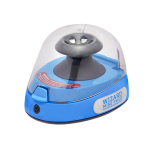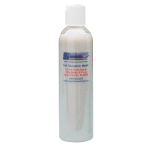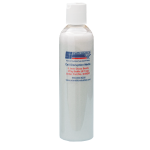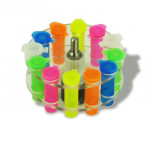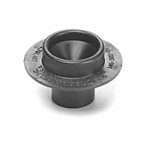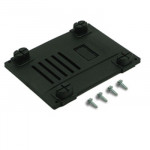Cell Disruption Using Glass Bead Media
Spherical lead free soda lime glass beads are commonly used for mechanical disruption of many yeast, bacterial and soil samples. Glass beads of a pre-determined size and volume are placed in a 1.5ml or 2.0ml microtube along with a pre-determined sample amount. The closed tube is then shaken vigorously at high speed, causing collisions between the glass beads and sample material. Scientific Industries’ Disruptor Genie® and TurboMix™ attachment for the Vortex-Genie 2 Family of Mixers are excellent choices for this process as they both simultaneously agitate and vortex at high speed, dramatically increasing cell or sample disruption. Each can hold up to twelve 1.5 ml or 2.0 ml microtubes at once. The disrupted cells may be removed after shaking for downstream processing.
Scientific Industries’ Disruptor Beads are packaged as 375g (8 fl. oz.) bottles in two sizes:
- 0.1 mm diameter beads (Catalog No. SI-BG01) — For use with Bacteria
- 0.5 mm diameter beads (Catalog No. SI-BG05) — For use with Yeast/Fungi
Care And Cleaning
Pre-preparation steps for Scientific Industries’ Disruptor Beads are generally unnecessary. If desired, they may be soaked in a 1:8 dilution of household bleach for 20 minutes, rinsed with copious amounts of distilled or RO water, and baked at 50 to 65°C for a minimum of 2 hours, or until completely dry. If the glass beads do not pour freely, repeat the cleaning and drying process. Disruptor Beads may also be autoclaved after proper disinfecting or cleaning.
The Disruptor Beads may be reused, if desired, after proper disinfecting or cleaning and autoclaving. Subsequent uses and excessive handling of the beads may result in the creation of fines, which could adversely affect cell disruption efficiency. As such, it is not recommended to frequently reuse Disruptor Beads.
Disruptor Beads may be stored at room temperature or frozen in an airtight container prior to use. In addition, the Disruptor Genie and TurboMix attachment for the Vortex-Genie 2 Family of Mixers may be used in cold rooms.
Sample Application Methods
NOTE: DETAILED DIRECTIONS FOR USE WILL DIFFER DEPENDING ON THE INDIVIDUAL PROTOCOL USED OR THE OUTCOME DESIRED. THE SAMPLE METHODS BELOW ARE EXAMPLES ONLY.
Bacteria Disruption:
Disruptor Beads, 0.1 mm diameter, are recommended for disruption of bacterial samples. A typical sample ratio would be 50% Disruptor Beads to 50% bacterial suspension by volume. This ratio may be adjusted as necessary. Allow head space (~20%) within the microtube to facilitate disruption action. It is recommended that beads and bacterial suspension be chilled prior to disrupting in order to offset any temperature rise within the microtube. Disruption at room temperature using chilled materials for 3 to 5 minutes at highest speed should be sufficient to recover 85% of the bacterial RNA. Disruption can be performed in a cold room as well. Samples should not be run for longer than 10 minutes consecutively to avoid any temperature rise.
Protocol for protein expression in Escherichia coli from a T7 expression system:
The following protocol is designed to provide approximately 1.5 mls of lysed cell supernatant that can be used for subsequent analyses. Inoculate 2 ml of Luria Broth (plus antibiotic) with an appropriate E. coli strain (i.e. BL21 DE3) containing an expression plasmid encoding the protein of interest. Incubate the culture at 37°C with shaking overnight. Inoculate the 2ml overnight culture into 40 mls of LB (plus antibiotic) and incubate until mid-log phase of growth (A600 = 0.4 - 0. 6). This step normally takes less than 2 hours. Add IPTG to 0.5 mM and incubate the culture for an additional 4 hours or more. Harvest the cells by centrifugation and then resuspend the cell pellet with 1.8 mls of buffer (50 mM TrisHCl, pH 7.5 or any other suitable buffer). Transfer 0.6 mls of the cell suspension to a 2 ml microtube and add 0.2 gms of 0.1 mm disruptor beads. Using greater quantities of beads (up to 0.5 gms) did not increase the efficiency of cell lysis. Close the tube and shake vigorously for 2 minutes with the TurboMix attachment to the Vortex-Genie or Disruptor Genie. Pellet the cells by centrifugation at maximum speed for 5 minutes in a microfuge. Take an aliquot of the supernatant for SDS-PAGE analysis and decant the rest of the supernatant into a new tube.
Yeast/Fungi Disruption:
Disruptor Beads, 0.5 mm diameter, are recommended for disruption of yeast or fungi samples. A typical sample ratio would be 50% Disruptor Beads to 50% of yeast or fungus suspension by volume. This ratio may be adjusted as necessary. Allow head space (~20%) within the microtube to facilitate disruption action. It is recommended that beads and yeast or fungus suspension be chilled prior to disrupting in order to offset any temperature rise within the microtube. Yeast cells and fungi are generally more difficult to shear than bacterial cells, so increased disruption times may be necessary. Disruption in a cold room with chilled materials for 5 to 7 minutes at highest speed should be sufficient to disrupt the cell sample. Samples should not be run for longer than 10 minutes consecutively to avoid any temperature rise.
Soil Sample Disruption:
Either size of Disruptor Beads can be used for soil samples. A typical sample ratio would be 50% Disruptor Beads to 50% soil sample suspension by volume. Allow head space (~20%) within the microtube to facilitate disruption action. Samples should not be run for longer than 10 minutes consecutively to avoid any temperature rise.


